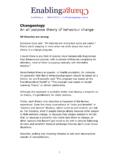Transcription of The problem with Social Marketing - Enabling Change
1 0414 674 674 | | Les Robinson 2009 1 The problem with Social Marketing Why you can t sell Change like soap By Les Robinson, Creator, Changeology If you work in health promotion or sustainability, you ll have heard of Social Marketing and Community-based Social Marketing . 1 I ve noticed that these communication methodologies are sometimes treated with almost magical reverence, as if they are the long-awaited silver bullets for the complex Social , health and environmental problems we struggle with . I believe many of the expectations placed on Social Marketing and its variants are overblown and Social Change practitioners need to be wary about claims made by their advocates. Here s why: Of course you can market brands. But behaviour Change is not like buying a different brand of beer, it s about getting people to DO THINGS THEY ARE UNCOMFORTABLE with , DON T WANT TO DO OR CAN T DO, or they would already be doing them.
2 Like parents letting their kids walk to school, or smokers quitting, or drivers switching to public transport. These kinds of Social , health and environmental behaviours are intractable because they are part of complex, wicked or messy Social problems. That s why they are still with us. They are intractable for very good reasons: they are fixed firmly in place by a powerful matrix of institutional, technological and Social factors. To be effective Change programs must therefore do more than just communicate persuasive messages, they must aim to modify those factors. Paul Stern of the Division of Behavioral and Social Sciences and Education of the UK s National Research Council explains that many behaviours are simply not amenable to voluntary Change : 2 This pattern of [contextual] influences implies that effective laws and regulations, strong financial incentives or penalties, irresistible technology, powerful Social norms, and the like can leave little room Les Robinson 2009 2 for personal factors to affect In other words, when people have very little choice how they act, structural changes (like regulation, pricing, infrastructure, service provision, governance reform, Social innovation, and technological innovation) should be the preferred approaches.
3 He goes on to say that: [however] when contextual influences are weak, personal likely to be the strongest influence on behavior. However, if we are realistic, there are very few situations where contextual factors are weak. Every personal decision is thoroughly embedded in its context. Even a simple voluntary behaviour like turning off the lights is determined by technology and pricing. The fact is, every effective Social Change effort has been predominantly structural. Improving the anti- Social behaviour of drinkers, for instance, has required collaboration between police, community leaders and licensing authorities; physical re-design of venues; modified management practices; training for staff; advocacy; political leadership; and legislative Change . Marketing has been the least important factor in the mix. Most solutions to wicked problems are like this. They involve multi-faceted strategies, and are very much about building relationships and re-designing practices, places and institutions, with Marketing often taking an important support role.
4 Of course there s nothing wrong with good Marketing . It s a vital part of the mix. It spreads knowledge, creates interest, helps get people buzzing, and helps spark political action so that politicians get busy with the work of changing institutions and supporting technological innovation. It is an important handmaiden of Change , but not the driver. Let s be clear what Social Marketing is Social Marketing 3 is a way of planning communication programs that aim to influence human behaviour. Community-based Social Marketing 4 (CBSM) is a variant that includes influence techniques drawn from Social psychology. Communication for Behavioural Impact 5 (COMBI) is another variant that s been designed for aid programs in developing countries. One of the most commonly heard definitions of Social Marketing is: Social Marketing is the application of commercial Marketing technologies to the analysis, planning, execution and evaluation of Les Robinson 2009 3 programs designed to influence the voluntary behaviour of target audiences to improve their personal welfare and that of society.
5 6 The practice of Social Marketing (and CBSM and COMBI are very similar) is said to consist of: 1) Start with a specific behavioural goal. 2) Conduct research with the target audience(s). 3) Be informed by psychological theories or models. 4) Tailor your efforts to suit the needs of the target audience(s). 5) Consider the 4 Ps: Product, Price, Place and Promotion. 6) Offer personal outcomes that the audience values. 7) Address the influence of competing promotions. This reads like applied common sense. You wouldn t want to design a communication campaign any other way. Perhaps the excitement that surrounds Social Marketing is partly due to what it replaced, which was a complete lack of method in the design of health promotion efforts. The problem with Social Marketing , however, is that changing human behaviour involves a lot more than a communication campaign. What s the evidence for Social Marketing As far as I can find, there has been only one systematic review of Social Marketing This 2007 review, funded by the UK s National Social Marketing Centre, analysed the results of 54 Social Marketing programs focusing on alcohol, tobacco, illicit drug use and physical activity.
6 The researchers concluded, in part: A majority of the [youth] significant positive effects in the short term. Effects tended to dissipate in the medium and longer These results are broadly comparable with systematic reviews of other types of substance use prevention interventions. The evidence is more mixed for adult smoking cessation, although small numbers of programs were nonetheless effective in this area. 8 [my emphasis] In other words, these Social Marketing programs were found to be about as effective as interventions not based on Social Marketing Les Robinson 2009 4 methodology, which, I assume, means other kinds of educational interventions. Notably, 48 of these 54 programs relied substantially on face-to-face tactics, like counselling and peer support, in addition to mass media. The results therefore can t be extrapolated to the great majority of Social Marketing campaigns, which consist primarily of mass media efforts.
7 Since face-to-face interaction generally has far greater personal impact than mass media communication, this systematic review probably overstates the effectiveness of Social Marketing . So what does work? Let s take the three behavioural challenges which have a strong emerging evidence base about what works and what doesn t work: tobacco cessation, road safety, and obesity prevention. What reduces tobacco smoking? According to a 2000 US National Cancer Institute study, media campaigns can produce reductions in smoking, but only when the rest of the Social structure actively changes the environment of the smoker. 9 A 2001 World Health Organisation review of anti-smoking campaigns from 9 countries and 6 US states and concluded that media campaigns can work when combined with counseling services, price increases, advertising bans and indoor smoking bans, and plenty of news stories. 10 A 2004 review concluded substantial evidence indicates that higher taxes and clean air laws can have a large impact on smoking rates.
8 Evidence also indicates that media campaigns when implemented with other policies are important. 11 What reduces road accidents? The World Health Organisation s 2004 "World Report on Traffic Injury Prevention", an authoritative global review of road safety interventions, does not mention Social Marketing , but notes when used in support of legislation and law enforcement, publicity and information can create shared Social norms for safety. However, when used in isolation, education, information and publicity do not generally deliver tangible and sustained reductions in deaths and serious injuries. 12 Les Robinson 2009 5 A 2004 systematic review into the effectiveness of anti-drink-driving programs concluded that mass media campaigns that are carefully planned and well executed, that reach a sufficiently large audience, and that are implemented together with other prevention activities such as highly-visible enforcement are effective in reducing alcohol-impaired driving and alcohol-related Summarising the evidence, Woolley (2001) 14 concluded that mass media advertising, when used alone, is unlikely to bring about significant road user behaviour Change .
9 However, advertising was found to play an important role in supporting other road safety activities, in particular enforcement. Barry Elliott, a Australian researcher who carried out a systematic review of road safety campaigns, summed it up pithily: you can t sell road safety like soap. 15 What reduces obesity? A recent US National Research Council report, Local Government Actions to Prevent Obesity provided a nice summary of the kinds of interventions that have the greatest potential to tackle childhood obesity. According to the press release: Many of these steps focus on increasing access to healthy foods and opportunities for active play and exercise. They include providing incentives to lure grocery stores to underserved neighborhoods; eliminating outdoor ads for high-calorie, low-nutrient foods and drinks near schools; requiring calorie and other nutritional information on restaurant menus; implementing local "Safe Routes to School" programs; regulating minimum play space and time in child care programs; rerouting buses or developing other transportation strategies that ensure people can get to grocery stores; and using building codes to ensure facilities have working water fountains.
10 In other words, if we wanted to run a comprehensive anti-obesity program then the skill mix would include an incentives manager, a regulator, a building code planner, a nutritionist, a transport planner, an educator (and a courageous politician or two to drive these changes) but not a marketer. So what, exactly, is wrong with Social Marketing ? Like most systems of practice or models, Social Marketing is good at the things it pays attention to. The problem is the things it does not pay attention to. In other words, its hidden assumptions: Les Robinson 2009 6 1) The behaviour is always right Social Marketing takes it as given that the particular behaviour should be adopted and can be adopted. It does not ask whether the prescribed behaviour make sense, whether it is capable of being adopted or whether it needs to be reinvented, matured, debugged, or replaced with an entirely different behaviour. Social Marketing almost invariably assumes the funders ideal behaviour or action is right, just, appropriate, and do-able.






